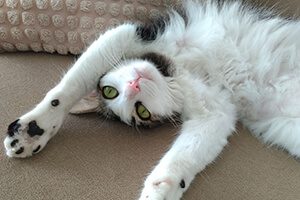It is common for your cat to have flaky, dry skin. If you spot white flakes coming out of your cat’s fur, there is a chance that it’s dandruff. The visible white flakes that come from your cat’s skin when brushed or touched, is usually when the skin is irritated, unhealthy, or the fur is matted. If cat dandruff is left untreated in Holmdel, NJ, it can cause more irritation and discomfort.
Fortunately, if you notice your cat is facing dandruff, there are many things one can do to help with this skin problem. The skin is a cat’s largest organ, so it’s important to always check for irritations, parasites or lumps. Figuring out the reason why or how your cat has this skin condition makes it helpful to identify if the case is serious or not.
There are many reasons for why your cat has developed dandruff and several ways to treat your cat to prevent it from happening again. However, it is always best to get professional advice from a vet regarding the skin situation.
Read more to learn what causes cat dandruff and potential ways to treat and avoid it.
What Is Dandruff in Cats?
Dandruff is caused when the sebaceous glands, which are responsible for producing oil in our skin, begins to overproduce. The oils that are produce helps to protect and nourish the skin. However, if the production becomes too much, it can start to irritate the cat’s skin, causing white flakes and excessive shedding than normal.
Cat dandruff can be described as a white speck found in the fur, on furniture or on your clothes. Their skin will look very dry and may be inflamed. Cat parents will notice how frequently their cats groom or scratch themselves, and may see some unusual bald patches or general hair loss.
Why Do Cats Have Dandruff?
If your cat is experiencing dandruff, there are several reasons to why they might have developed this skin problem. Finding out the cause of the dandruff can be a guide to fixing the aliment.
Dehydration
Every living thing needs a lot of water, including cats – around an ounce per pound of body weight a day. If your cat isn’t drinking a lot of water, it can cause flaky dry skin and weight loss. A dry environment can also cause skin dryness if the environment is too warm. It can dry out the skin and trigger over-production of oil.
Health Issues
Cat dandruff can also be a signal of a potential health problem, like bacteria or parasites (fleas, lice, ringworm, ticks or mites), weight loss, allergies or feline diabetes. If you notice these signs, check your veterinarian to rule out any other health issues you might not have occurred before threating them for their dandruff. A bacterial or fungal infection can also be the problem, as well as a yeast infection. There are some conditions that is called walking dandruff, it is caused by the Cheyletiella mite. If your cat uses flea control products, this might not be a problem.
Lack of Fatty Acids in Diet
Oil is very essential to the skin, and, similar humans, cats need a balance diet to remain in shape and healthy. Omega fatty acids are especially helpful to maintain a healthy and oily skin, so if your cat has a dry skin, it might be that there is a lack of these essential nutrients. The process of a renewed skin cell is used up to 30% of your cat’s protein intake, so it important that their diet includes high digestible proteins that are high quality, so it can be easier to be absorbed into their system.
Omega-3 and Omega-6 are essential fatty acids which contribute to their overall health, and should be included in their daily diet. Other certain vitamins, such as vitamin A and Vitamin C, help to regulate the blood cells, contributes in healthy skin and regulate cell growth.
Grooming Issues
If you see clumps near the base of your cat’s tail or flakiness on their hair, it means your cat is unable to reach that place properly and can’t groom well. Excessive grooming can also cause skin problems – this is most common for indoor cats.
Bathing Products
If you bathe your cat regularly, using products that have some harmful chemicals can irritate their skin.
What Are the Symptoms of Cat Dandruff in Holmdel, NJ?
In order to identify cat dandruff in Holmdel, NJ, accurately, it is important for cat owners to know the leading signs of the skin condition. The symptoms of the skin problem are very similar to that in humans.
Flaky Skin
This is the most common and noticeable sign of cat dandruff: a dry and flaky skin. If your cat has darker fur, the white flakes would appear more and easily be visible. If your cat has thick fur, you might have to part a section in order to see any dry skin.
Cat Hair Loss
Constant licking and itching can lead to bald patches and hair loss. If you notice patches in your cat’s skin, check what is causing your cat’s dandruff is imperative, as it can lead to severe skin damages.
Scaly, Thick Patches
Cat owners may also find hard, scaly and thick patches of dry skin that is accompanied by their excessive amount of flaky skin.
Irritated, Red Patches
If the dandruff is too severe, it can cause irritation and you may find red, inflamed patches. This is due to the excessive scratching and licking. The excessive itching can break and open the skin, which leads to development of infection.
How to Prevent Cat Dandruff
Once you have your cat’s dandruff under control, you would need to know ways to prevent them from reoccurring. Here are a few things cat owners need to apply to prevent dandruff:
- Grooming and brushing your cat regularly
- Bathing your cat (Avoid over-bathing)
- Keep your cat hydrated
- Feed your cat a healthy and nutritious diet: Include fatty acid (Omega-3, Omega-6, Coconut oil)
- Avoid Stressors
- Moisturize your cat
- Try a special shampoo, recommended by your veterinarian.
- Use a humidifier at home
Our Holmdel, NJ, Veterinarians Can Help with Your Cat’s Dandruff
Dandruff in cats is common and easy to treat, but if the problem becomes worse, our animal hospital in Holmdel, NJ, can help! Give us a call to schedule an appointment for your cat at (732) 671-3110.

